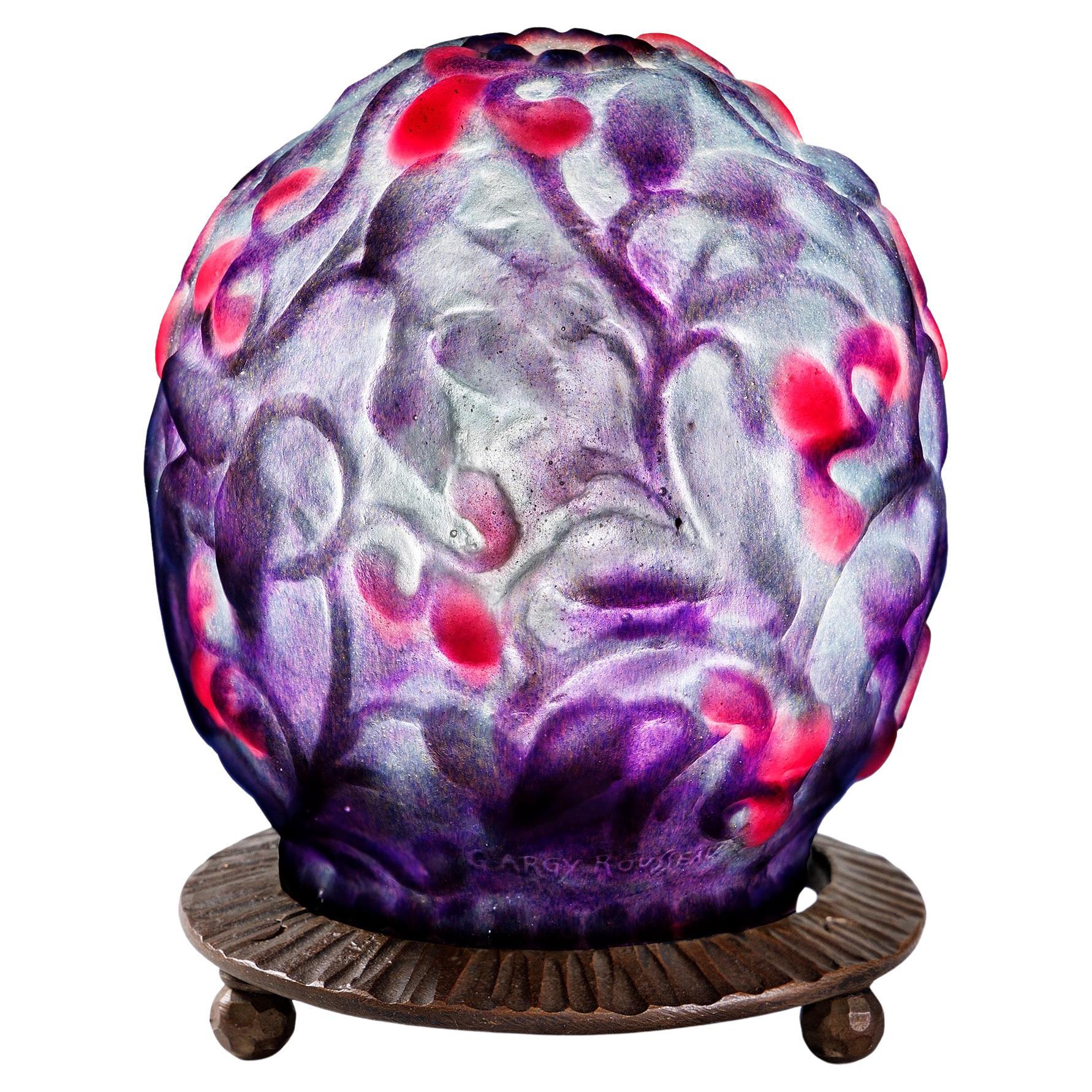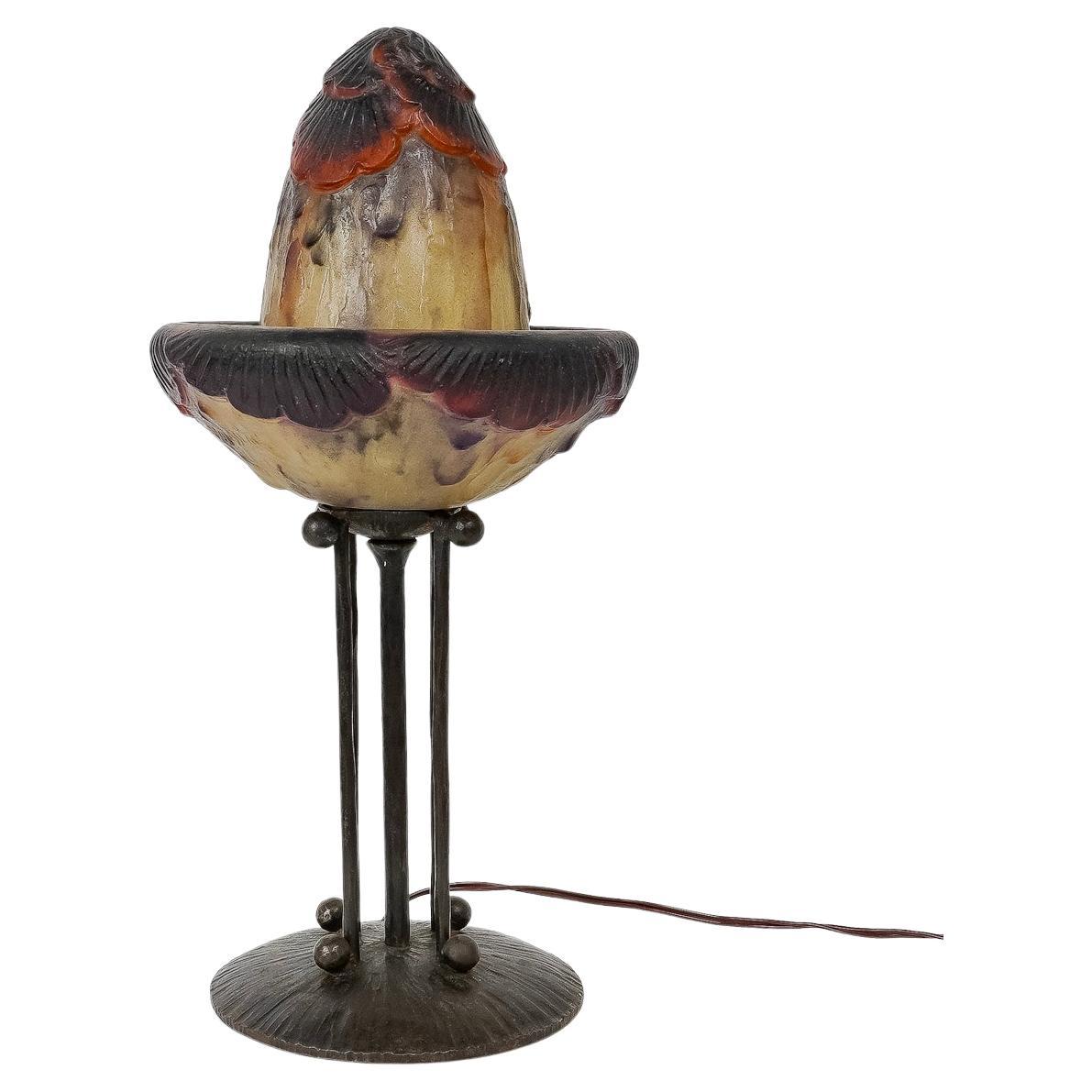Items Similar to Gabriel Argy-Rousseau (1885-1963) « Danseuses sous les projecteurs' » Veilleuse
Want more images or videos?
Request additional images or videos from the seller
1 of 7
Gabriel Argy-Rousseau (1885-1963) « Danseuses sous les projecteurs' » Veilleuse
About the Item
Gabriel Argy-Rousseau (1885-1963)
A « Danseuses sous les projecteurs' » Veilleuse, circa 1928
Pâte-de-verre
Original wrought-iron base
signed in the mold G. ARGY-ROUSSEAU
H 12,5 cm L 8,2 cm P 6,2 cm
cf. J. Bloch-Dermant, Les Pâte de Verre Catalogue Raisonné G. Argy-Rousseau, Paris, 1990, p. 217, no. 28.07 for another veilleuse of this model.
Joseph Gabriel Rousseau dit Gabriel Argy-Rousseau (1885-1953) is a French sculptor, cer-amist and master glassmaker who contributed to the rediscovery of glass paste as a major glass art of the early twentieth century. If the technique of glass paste dates back to antiqui-ty, it falls very long into oblivion. In the last quarter of the 19th century, Henri Cros and a handful of artists, often ceramists of the Art Nouveau movement, such as François Décor-chemont or Georges Despret, put it in the spotlight. The last of these precursors is Gabriel Argy-Rousseau. He is considered the only glassmaker to have developed and used the com-plex process of glass paste, the other master glassmakers working crystal paste.
He entered the Ecole de céramique de Sèvres, where he discovered glass paste in the work-shop of Henri Cros. Gabriel Argy-Rousseau began producing between 1910 and 1920. His early works were influenced by the plant and animal motifs of Art Nouveau. He began at the Salon des artistes français in 1914 in Paris. Between 1921 and 1931, established rue Sim-plon in Paris, he was a shareholder of the Argy-Rousseau Glass Pasta Company. With many collaborators, he produced small very colorful subjects in the Art Nouveau and Art Deco style, distributed in small series: pendants, vases, lamps and night lights and, from 1928, sculptures (statuettes or bas-reliefs) in collaboration with Marcel Bouraine. Unlike his fel-low ceramists, he was late faithful to the polychrome effects and floral motifs of Art Nou-veau. He develops shimmering colours (ruby red, amethyst, grey, deep blue, etc.) and tex-tures with marbled effects. He invented new processes of surface colouring of the dough, by brushing oxide powder before second low-temperature cooking. His works are in glass paste, statuettes usually in crystal paste.
Gabriel Argy-Rousseau’s glass creations remain among the most typical and representative examples of Art Deco production. The production of the workshop ceased in 1931, but Argy-Rousseau continued to create crystal paste pieces, no longer having, due to the economic crisis, the possibility of working the very expensive glass paste process. He exhibited occa-sionally, notably in 1934, glassware decorated with pre-heaven metals. His last exhibition took place a year before his death in 1952. He died forgotten, but left an important body of work in the field of glass, now rediscovered.
- Creator:Gabriel Argy-Rousseau (Maker)
- Dimensions:Height: 12.5 in (31.75 cm)Width: 8.2 in (20.83 cm)Depth: 6.2 in (15.75 cm)
- Power Source:Plug-in
- Lampshade:Included
- Style:Art Deco (Of the Period)
- Materials and Techniques:
- Place of Origin:
- Period:
- Date of Manufacture:circa 1928
- Condition:Wear consistent with age and use.
- Seller Location:Saint-Ouen, FR
- Reference Number:1stDibs: LU2612337668162
About the Seller
4.9
Vetted Seller
These experienced sellers undergo a comprehensive evaluation by our team of in-house experts.
1stDibs seller since 2017
56 sales on 1stDibs
Typical response time: 1 hour
- ShippingRetrieving quote...Ships From: Saint-Ouen, France
- Return PolicyA return for this item may be initiated within 2 days of delivery.
More From This SellerView All
- Raphaël DELORME (1885-1962) « Jeune femme dans son intérieur »By Raphael DelormeLocated in Saint-Ouen, FRRaphaël DELORME (1885-1962) « Jeune femme dans son intérieur » Oil on panel Signed Lower right Framed 36 x 32 cm Total 50 x 47 cm Raphaël Delorme was a French painter born in 1885 ...Category
Vintage 1920s French Art Deco Paintings
MaterialsWood, Paint
- Pair of Porcelain Vases Ormolu-Mounted in Lamps by Gagneau Paris XIXth CenturyBy Gagneau ParisLocated in Saint-Ouen, FRPair of large Japanese Porcelain Cone Shape Vases with Imari decoration Important mounts in ormolu and gilded metal, the base decorated with a laurel wreath, the upper part of falling leaves and a frieze of knotted ribbon. The mounts signed Gagneau, 115 R. Lafayette. Circa 1860 With their original aluminium bulb cover and original gilding Vase it self Height 47 cm The Gagneau Company is one of the most famous lighting factories in Paris in the nine-teenth century, established in 1800 at 25 rue d'Enghien in Paris and later at 115 rue de Lafayette. She has participated in many exhibitions throughout this century. She began in 1819 with the Exposition des Produits de l'Industrie and later participated in the Universal Exhibitions where she was part of the jury in the category of art bronzes (class 25) at the Universal Exhibition in Paris in 1889. "Imari" was simply the trans-shipment port for Arita wares, from where they went to the for-eign trading outposts at Nagasaki. It was the kilns at Arita which formed the heart of the Japanese porcelain industry. Arita's kilns were set up in the 17th century, after kaolin was discovered in 1616. A popular legend attributes the discovery to an immigrant Korean potter, Yi Sam-Pyeong (1579–1655), although most historians consider this doubtful. After the discovery, some kilns began to produce revised Korean-style blue and white porcelains, known as Early Imari, or "Shoki-Imari". In the mid-17th century, there were also many Chinese refugees in northern Kyushu due to the turmoil in China, and it is said that one of them brought the overglaze enamel coloring technique to Arita. Thus Shoki-Imari developed into Ko-Kutani, Imari, and later Kakiemon, which are sometimes taken as a wider group of Imari wares. Ko-Kutani was produced around 1650 for both export and domestic market.Kutani Ware is characterized by vivid green, blue, purple, yellow and red colors in bold designs of landscapes and nature. Blue and white porcelain pieces continued to be produced and they are called Ai-Kutani. Ko-Kutani Imari for the export market usually adopted Chinese design structure such as kraak style, whereas Ai-Kutani for the domestic market were highly unique in design and are ac-cordingly valued very much among collectors. Ko-Kutani style evolved into Kakiemon-style Imari, which was produced for about 50 years around 1700. Kakiemon was characterized by crisp lines, and bright blue, red and green designs of dramatically stylized floral and bird scenes. Imari achieved its technical and aes-thetic peak in the Kakiemon style, and it dominated the European market. Blue and white Kakiemon is called Ai-Kakiemon. The Kakiemon style transformed into Kinrande in the 18th century, using underglaze blue and overglaze red and gold enamels, and later additional colors. Imari began to be exported to Europe when the Chinese kilns at Jingdezhen were damaged in the political chaos and the new Qing dynasty government halted trade in 1656–1684. Ex-ports to Europe were made through the Dutch East India Company, and in Europe the des-ignation "Imari porcelain" connotes Arita wares of mostly Kinrande Imari. Export of Imari to Europe stopped in mid-18th century when China resumed export to Eu-rope, since Imari was not able to compete against Chinese products due to high labor costs. By that time, however, both Imari and Kakiemon styles were already so popular among Eu-ropeans that the Chinese export porcelain copied both, a type known as Chinese Imari. At the same time, European kilns, such as Meissen and English potteries such as Johnson Bros. and (Royal) Crown Derby, also imitated the Imari and Kakiemon styles. Export of Imari surged again in late 19th century (Meiji era) when Japonism flourished in Europe.Thus, in the western world today, two kinds of true Japanese Imari can...Category
Antique 1880s French Japonisme Table Lamps
MaterialsBronze
- Émile GALLE (1846-1904) "Paysage Vosgien" Glass Lamp circa 1900By Emile GalléLocated in Saint-Ouen, FRÉmile GALLE (1846-1904) "Paysage Vosgien" A multilayer glass lamp by Gallé With an etched decor of a green and blue Vosgien landscape on the foot and of flying eagles on the lamps...Category
Antique Early 1900s French Art Nouveau Table Lamps
MaterialsBronze
- Émile Gallé (1846-1904) French Enameled Ring Tree Cristallerie circa 1885By Emile GalléLocated in Saint-Ouen, FRÉmile Gallé (1846-1904) Extremely Rare Baguier shaped tree trunk blue “light blue moon” (Clair de Lune) glass enameled designed with two grasshoppers, an ant and a fly. Signed E.Gall...Category
Antique 1880s French Japonisme Glass
MaterialsArt Glass
- "Ce qu'évoquent les Livres" by Émile Aubry '1880-1964'By Louis AubryLocated in Saint-Ouen, FR"Ce qu'évoquent les Livres" Allegory of the Literature Oil on canvas Signed on the lower part beside parchment 111 x 133 x 2 cm Framed 125 x 146 x 7 cm Provenance: Collection Georges AUBRY, brother of the artist Bibliography: Illustrated in catalogue «Regards de peintre» , Suzanne AUBRY-CASANOVA, 1997, p.104 After trying years of forced confinement due to the war, he composed this allegorical fresco on the theme of Literature, Science and Arts was painted by Émile Aubry for his younger brother Georges Aubry, who had intended it for his library. This work, composed on the theme of the book it symbolizes, in its diversity by allegorical characters, he cannot help ordering the painting around Art, which he places at the top of the scale of human...Category
Vintage 1940s French Art Deco Paintings
MaterialsCanvas
- Pierre Le Faguays (1892~1962) "Dancer of Thyrsus" An Art Deco Bronze FigureBy Pierre Le FaguaysLocated in Saint-Ouen, FRPierre Le Faguays (1892~1962) "Dancer of Thyrsus" An Art Deco Bronze Figure circa 1930 An iconic Art Deco cold painted gilt and patinated bronze sculpture of a semi-naked dancer hold...Category
Vintage 1920s French Art Deco Figurative Sculptures
MaterialsMarble, Bronze
You May Also Like
- Gabriel Argy-Rousseau Pâte de Verre "Fleurs Tropicales" Table LampBy Gabriel Argy-RousseauLocated in New York, NYArgy-Rousseau's near-unique ability to gracefully soften the starkness of Art Deco design without ever sacrificing the strength of the design is on full display in this remarkable, p...Category
Early 20th Century French Art Deco Table Lamps
MaterialsWrought Iron
- 1926 Gabriel Argy Rousseau Nightlamp Corollas Corolles Pate De Verre GlassBy Gabriel Argy-RousseauLocated in Boulogne Billancourt, FRNightlamp "Corolles" (The Corollas) made in amber, yellow and brown glass pate-de-verre by Gabriel Argy-Rousseau in 1926. Wrought iron base. New wiring. Molded signature. Perfect co...Category
Vintage 1920s French Art Deco Table Lamps
MaterialsBlown Glass
- Gabriel Argy-Rousseau Pâte de Verre "Fruits et Feuilles" Night LightBy Gabriel Argy-RousseauLocated in New York, NYArgy-Rousseau's near-unique ability to gracefully soften the starkness of Art Deco design without ever sacrificing the strength of the design is on full display in this remarkable, p...Category
Early 20th Century French Art Deco Table Lamps
MaterialsWrought Iron
- 1925 Gabriel Argy Rousseau Nightlamp Exotic Foliage Pate De Verre GlassBy Gabriel Argy-RousseauLocated in Boulogne Billancourt, FRNightlamp "Feuillage Exotique" (Exotic Foliage) made in yellow, red and purple glass pate-de-verre by Gabriel Argy-Rousseau in 1925. Original wrought iron base. New wiring. Molded si...Category
Vintage 1920s French Art Deco Table Lamps
MaterialsBlown Glass
- 1923 Gabriel Argy Rousseau, Nightlamp Panier Fleuri Pate De Verre GlassBy Gabriel Argy-RousseauLocated in Boulogne Billancourt, FRNightlamp "Panier Fleuri" (Flowered Bowl) made in blue, green, pink/purple and black glass pate-de-verre by Gabriel Argy-Rousseau in 1923. Original wrought iron base. Molded signatur...Category
Vintage 1920s French Art Deco Table Lamps
MaterialsBlown Glass
- 1927 Gabriel Argy Rousseau, Nightlamp Fleurs Et Bourgeons Pate De Verre GlassBy Gabriel Argy-RousseauLocated in Boulogne Billancourt, FRNightlamp "Fleurs de Bourgeons" made in red, purple and black glass pate-de-verre by Gabriel Argy-Rousseau in 1927. Original wrought iron base. Molded signature. Perfect conditi...Category
Vintage 1920s French Art Deco Table Lamps
MaterialsBlown Glass
Recently Viewed
View AllMore Ways To Browse
French Art Deco Sculpture Table Lamp
French Floral Metal Table Lamp
Sevres Art Nouveau Vases
Floral Crystal Table Lamp
Ruby Paste
Dior Amethyst
Carved Animal Lamp
Argy Rousseau Veilleuse
Murano Frosted Glass Table Lamp
French Art Deco Industrial Dining Table
James Mont Hollywood Regency Lamp
Murano Gino Vistosi Lamp
Vintage Giltwood Lamps
Reverse Painted Glass Shade
Acrylic Bedside Tables
Heywood Wakefield Wicker Lamps
Original Hanau Lamp
1980s Ozeki





